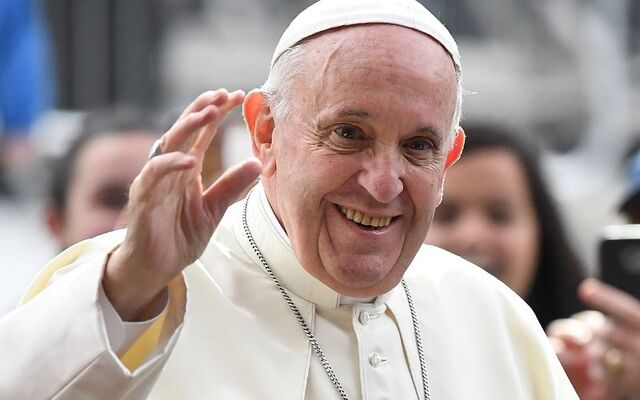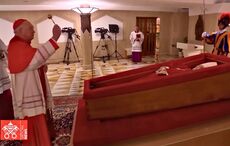The Vatican has confirmed plans for the public viewing of Pope Francis and a funeral Mass for the late Pontiff, with Dublin-native Kevin Joseph Farrell, the Camerlengo, to play a key role in the coming days.
As Camerlengo, Farrell, who was born and raised in Drimnagh in Dublin, has a number of duties surrounding the death of Pope Francis.
Farrell was the one to formally announce the passing of Pope Francis on Monday, and later in the day, he presided over the rite of ascertainment of death and placement of the late Pope Francis’ body in the coffin in a ceremony in the chapel of the Vatican's Casa Santa Marta.
He also joined Cardinal Pietro Parolin and Archbishop Edgar Peña Parra on Monday to seal the doors of the papal apartment in the Apostolic Palace and the door to the apartment of the Casa Santa Marta, where the late Pope Francis lived.

Camerlengo Kevin Farrell, a native of Dublin. (RollingNews.ie)
Pope Francis' body to lie in state
The Vatican announced on Tuesday that at 9 am on Wednesday, April 23, the coffin of Pope Francis will be carried from the Chapel of the Domus Sanctae Marthae (Casa Santa Marta) to the Papal Basilica of Saint Peter.
Farrell will lead the procession and, after a moment of prayer, will preside over the rite of translation.
The procession will cross Piazza Santa Marta (Santa Maria Square) and Piazza dei Protomartiri Romani (Square of the Roman Protomartyrs). From the Arco delle Campane (Arch of the Bells), it will enter St. Peter’s Square and enter the Vatican Basilica via the central door.
At the Altar of the Confessio, Farrell will preside over the Liturgy of the Word, at the end of which the visits to the body of Pope Francis will begin.
According to Vatican News, St. Peter's Basilica will remain open to those who wish to pay their respects from 11 am to midnight on Wednesday, 7 am to midnight on Thursday, and 7 am to 7 pm on Friday.
View this post on Instagram
Funeral for Pope Francis
The Vatican also confirmed on Tuesday that the funeral Mass for Pope Francis will be held at 10 am on Saturday, April 26, at St. Peter's Basilica.
Saturday, the Vatican said, is the first day of the Novendiali, the nine days of mourning and Masses for the repose of Pope Francis' soul.
According to the Associated Press, the night before the funeral, Farrell is set to preside over the closing and sealing of Pope Francis' coffin, in the presence of other senior cardinals. A white cloth is placed over the pope’s face.
On Saturday, the funeral liturgy will be presided over by Cardinal Giovanni Battista Re, Dean of the College of Cardinals. Patriarchs, Cardinals, Archbishops, and Bishops are permitted to concelebrate.
The Vatican said that at the end of the Eucharistic Celebration, the Ultimo commendatio, or concluding prayer, and Valedictio, or formal farewell, will take place.
The coffin of Pope Francis will be taken to St. Peter’s Basilica, and from there to the Basilica of St. Mary Major for burial, as per the Pope's indications.

Pope Francis in Dublin, Ireland in August 2018. (RollingNews.ie)
General Congregation of Cardinals
Meanwhile, the first General Congregation of the College of Cardinals took place in the Vatican on Tuesday, marking the beginning of a period of prayer, reflection, and preparation following the death of Pope Francis.
Approximately 60 cardinals gathered in the Synod Hall for the occasion.
During the congregation, Farrell read Pope Francis' testament aloud.
A commission of three Cardinals was selected during Tuesday's gathering to assist Farrell in the governance of the Church during the sede vacante, the period when the papal office is unoccupied. These three Cardinals represent the three orders of the College of Cardinals and are replaced every three days. The first group of three Cardinals thus chosen are Pietro Parolin (episcopal order), Stanisław Ryłko (presbyteral order), and Fabio Baggio (diaconal order).
The College of Cardinals also decided on Tuesday to suspend the scheduled beatification celebrations until the new Pope can deliberate.
When does the papal conclave begin?
The papal conclave, the process by which a new pope is elected in the Catholic Church, must begin no earlier than 16 days after the pope’s passing, and no later than 21 days.
Vatican News notes that as of Monday, the College of Cardinals, the body responsible for electing the Pope, included 135 Cardinal Electors, 133 of whom were appointed by Pope Francis, and 117 non-electors. Those who have already turned 80 years old on the day the Sede Vacante begins are excluded. However, Cardinals over 80 may still participate in preparatory meetings, such as the General Congregations preceding the election.
All election procedures take place exclusively in the Sistine Chapel within the Vatican Apostolic Palace, which remains completely sealed off until the election is concluded.
To validly elect a new Pope, a two-thirds majority of the electors present is required. If the total number of electors is not evenly divisible by three, an additional vote is necessary.
If voting begins on the afternoon of the first day, there will be only one ballot. On subsequent days, two ballots are held in the morning and two in the afternoon.
If the electors fail to reach an agreement on a candidate after three days of inconclusive voting, a break of up to one day is allowed for prayer, free discussion among voters, and a brief spiritual exhortation by the Cardinal Proto-Deacon, Cardinal Dominique Mamberti.
Voting then resumes, and if no election occurs after seven additional ballots, another break is taken.
This process repeats after another seven unsuccessful ballots. At this point, the Camerlengo will consult with the Cardinals on how to proceed.




Comments